Alamance-Burlington schools grapple with financial strain after summer mold crisis
Following a mold outbreak and expensive remediation this summer, the Alamance-Burlington School System finds itself facing a cycle of spending
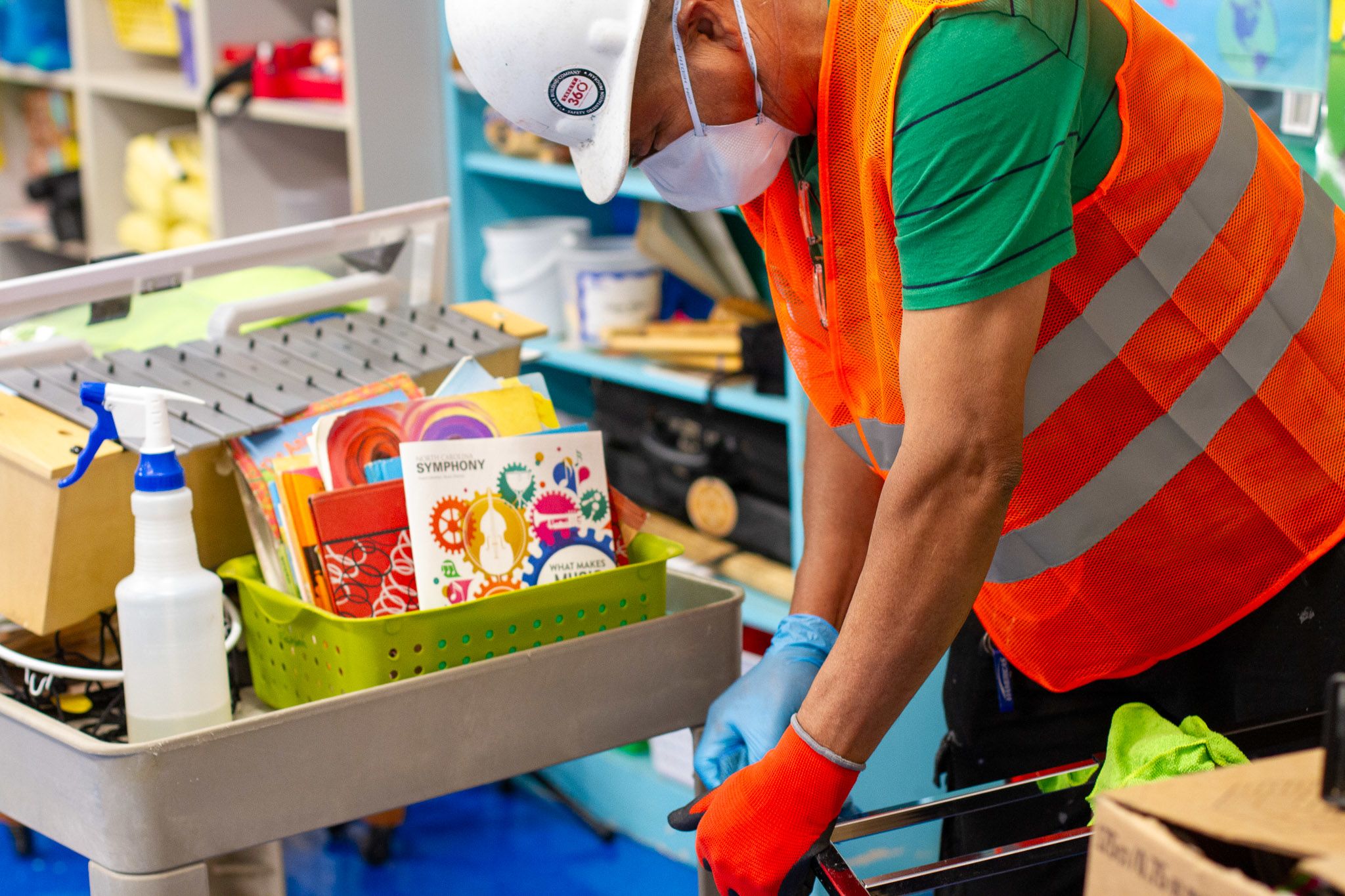
To prepare for school this year, Brandy Whittaker sat down with her two children and talked to them about the usuals — making friends, new teachers and more.
And then school didn’t start. So Whittaker broached a new topic with her children — what is mold?
“The conversation for us was the adults didn't do their jobs and unfortunately we just can't go to school this week, maybe next week,” Whittaker said.
Mold was found in 32 of the 36 Alamance-Burlington School System schools in August — prompting an expensive clean-up and delaying the school year two weeks. Of the schools that tested positive, toxigenic mold was identified in 16 of them. Months later, the school system is still lacking the resources to implement measures to prevent the mold from returning.
Though the work done in August and early September made it safe for students to return to school, the remediation did not address the root of the problem. Executive Vice President Ben Bass of Builders Services — one of the companies hired to clean the schools — presented photographs to the Alamance County Commissioners of roof leaks and heating, ventilation and air conditioning problems his company found while cleaning the schools. Bass told them that without immediately fixing the conditions that allowed mold to grow, it will grow back.
“When I tell you these buildings are leaking, I'm not talking about a drip, drip — we're talking it’ll fill up a 44 gallon trash can in less than an hour. They're leaking that bad in certain places,” Bass said at the Sept. 18 county commissioners meeting.
But the biggest obstacle the school district faces is funding. According to ABSS Public Information Officer Les Atkins, ABSS has no taxing authority and therefore cannot raise its own funds. Because of that, the district has to request all of its funding from the county commissioners.
“I think what we had here was a business problem,” Atkins said. “This is years and years and years of underfunding for certain projects, and then all of the sudden, you realize that there's an explosion.”
Many of the school district’s top officials, including ABSS Superintendent Dain Butler and much of his cabinet, are newer to the school system; Butler, for example, started his position in July 2022. Atkins said because he is newer to ABSS, Butler wanted to do a thorough check of all of the schools.
“What we found was that some small things that maybe had been left unattended to were big things,” Atkins said. “Maybe that little bit of water intrusion that we were alerted to at some point, maybe a year or so before, maybe we thought, ‘Well, that was fixed or that was corrected,’ and now that's turned into toxigenic mold behind the wall.”
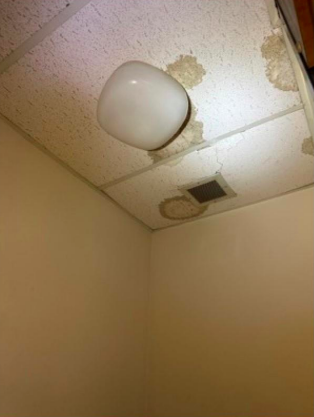
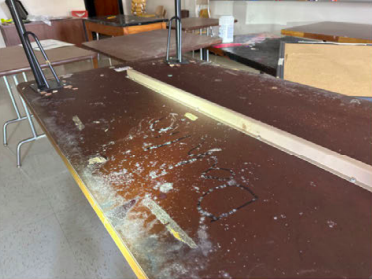
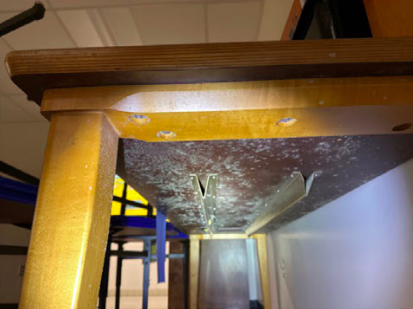
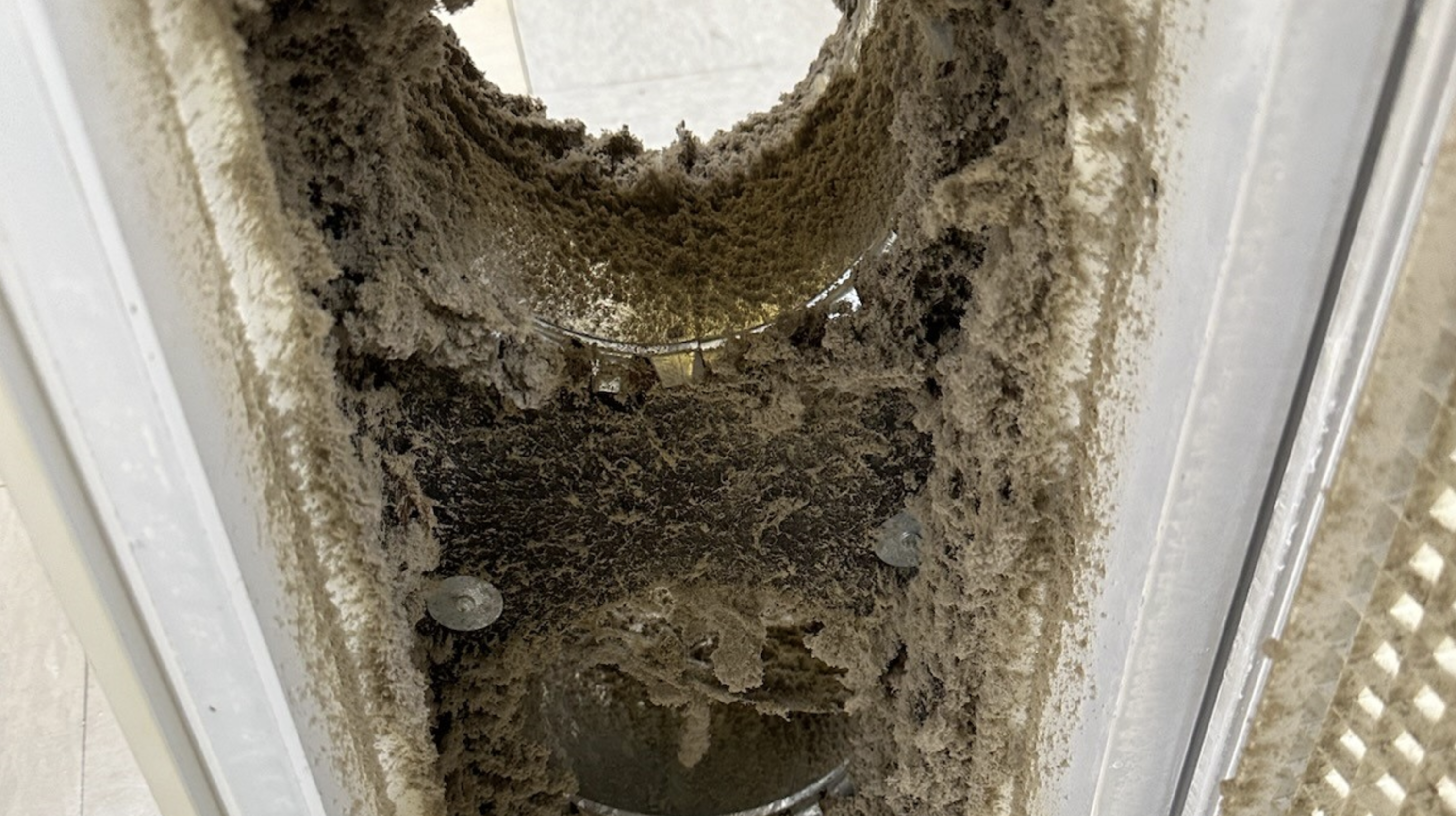
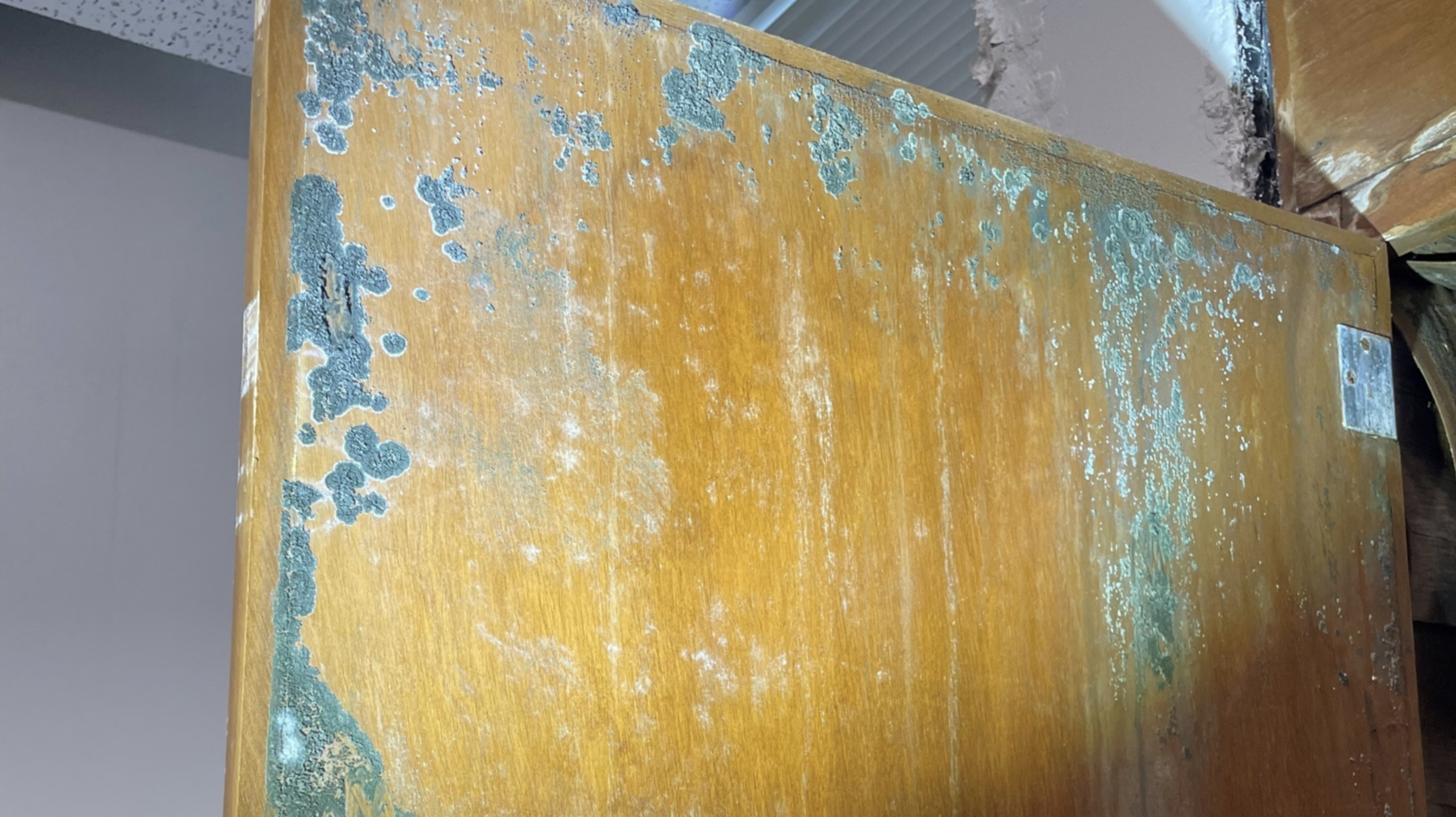
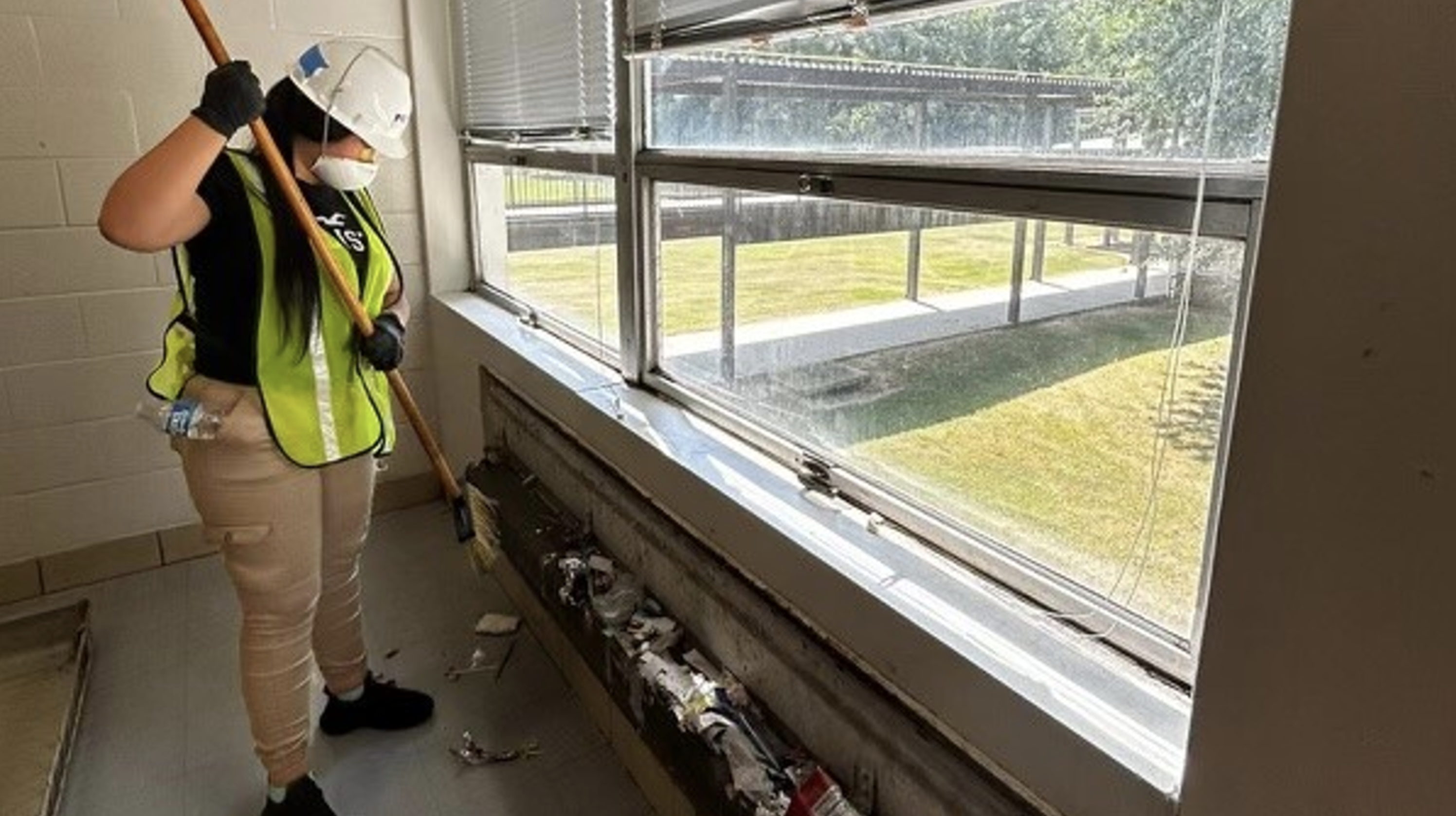
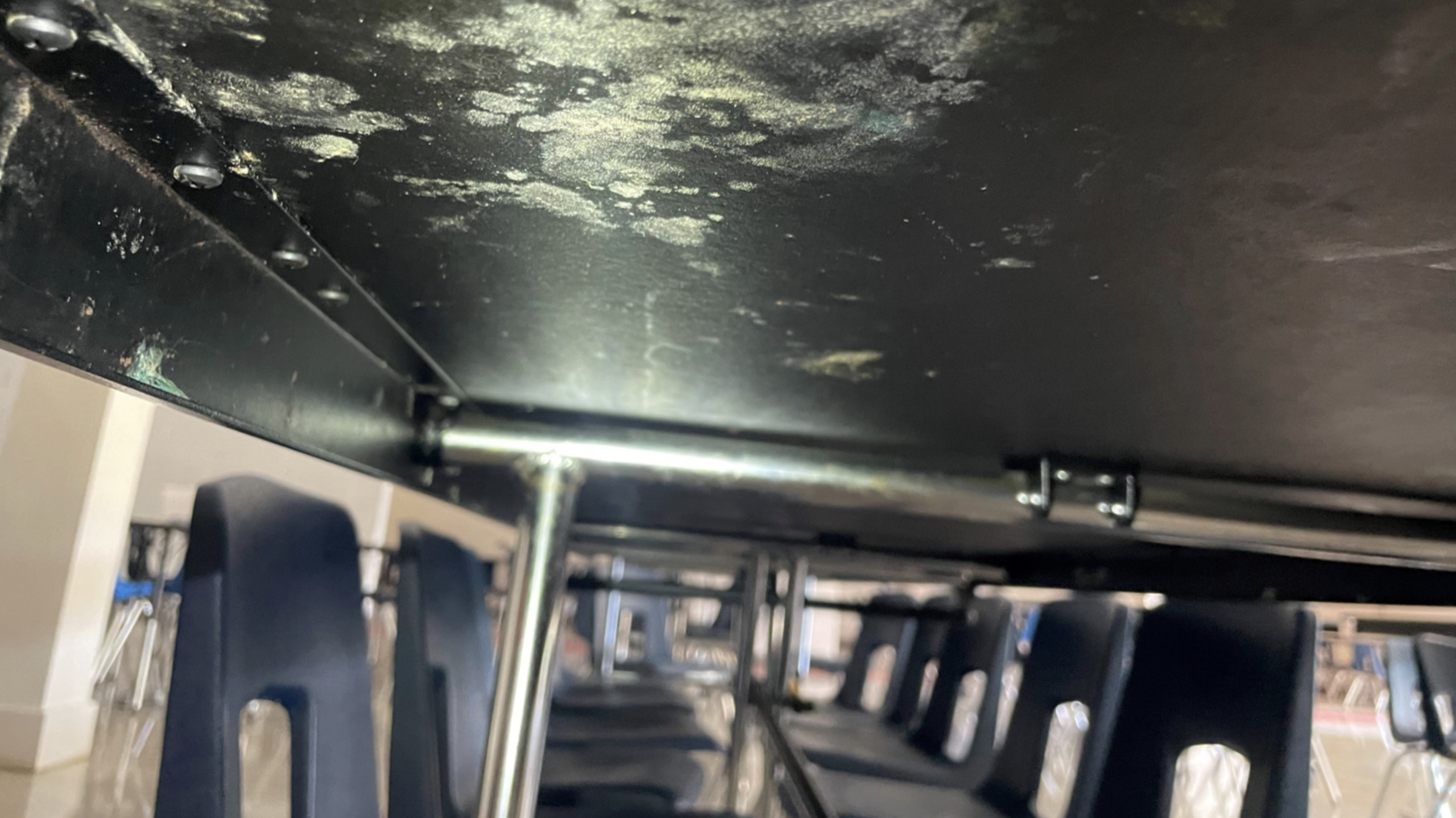

Water damage found on ceiling tiles in a bathroom at Andrews Elementary School during an indoor environmental air quality assessment prior to remediation. Andrews Elementary was the first school where mold was discovered. Photo by Environmental Solutions Group.
Water damage found on ceiling tiles in a bathroom at Andrews Elementary School during an indoor environmental air quality assessment prior to remediation. Andrews Elementary was the first school where mold was discovered. Photo by Environmental Solutions Group.

Heavy mold growth found under a table at Cummings High School during an indoor environmental air quality assessment prior to remediation. Photo by Environmental Solutions Group.
Heavy mold growth found under a table at Cummings High School during an indoor environmental air quality assessment prior to remediation. Photo by Environmental Solutions Group.

More mold growth found under a table at Broadview Middle School during an indoor environmental air quality assessment prior to remediation. Photo by Environmental Solutions Group.
More mold growth found under a table at Broadview Middle School during an indoor environmental air quality assessment prior to remediation. Photo by Environmental Solutions Group.

A photos from inside an unknown ABSS school during mold remediation. Photo courtesy of Ben Bass, the executive vice president of Builder Services, one of the companies hired by ABSS to clean mold from schools and facilities.
A photos from inside an unknown ABSS school during mold remediation. Photo courtesy of Ben Bass, the executive vice president of Builder Services, one of the companies hired by ABSS to clean mold from schools and facilities.

A photos from inside an unknown ABSS school during mold remediation. Photo courtesy of Ben Bass, the executive vice president of Builder Services, one of the companies hired by ABSS to clean mold from schools and facilities.
A photos from inside an unknown ABSS school during mold remediation. Photo courtesy of Ben Bass, the executive vice president of Builder Services, one of the companies hired by ABSS to clean mold from schools and facilities.

A photos from inside an unknown ABSS school during mold remediation. Photo courtesy of Ben Bass, the executive vice president of Builder Services, one of the companies hired by ABSS to clean mold from schools and facilities.
A photos from inside an unknown ABSS school during mold remediation. Photo courtesy of Ben Bass, the executive vice president of Builder Services, one of the companies hired by ABSS to clean mold from schools and facilities.

A photos from inside an unknown ABSS school during mold remediation. Photo courtesy of Ben Bass, the executive vice president of Builder Services, one of the companies hired by ABSS to clean mold from schools and facilities.
A photos from inside an unknown ABSS school during mold remediation. Photo courtesy of Ben Bass, the executive vice president of Builder Services, one of the companies hired by ABSS to clean mold from schools and facilities.
In a preventative plan Butler proposed to county commissioners on Sept. 18, Butler asked for an estimated $30 million per year for the next five years to upgrade HVAC systems in up to eight schools and an additional estimated $15 million per year to fix and replace roofs in up to four schools — totaling $225 million after five years.
For perspective, that would be about 18% of the funding for the entire county per year — assuming the county budget remains about the same.
Alamance County commissioners allotted $52.9 million in its budget ordinance for ABSS this fiscal year, which runs from July 2023 through June 2024. According to ABSS school board member Seneca Rogers, the school system uses this budget to run the schools, pay staff and more. In addition to that budget, the school system requests money each year to be earmarked in the county’s capital reserves to be used specifically for special projects.
When the mold was discovered, the county commissioners worked with the school board to move capital reserve money earmarked for ABSS projects to fund the remediation. ABSS spent $25.8 million on immediate needs, such as remediation in all schools with mold and HVAC cleaning in schools with toxigenic mold, Atkins said. Now, he said, the school system only has a balance of $102 thousand to use in emergency situations.
“At this point, we're sort of paralyzed in our ability really to move forward unless the county commissioners see fit to give us more money,” Atkins said.
BY THE NUMBERS
36
schools are in the Alamance-Burlington School System.
32
schools tested positive for any type of mold.
16
schools tested positive for toxigenic mold.
$25.8 million
was the total amount spent on mold remediation.
$102 thousand
is ABSS's remaining fund balance.
Whittaker doesn’t believe the county has done enough.
“They basically just shifted funds around. What we didn't see was the county itself placing funds into the school system,” Whittaker said. “These are county buildings, they are technically owned by our county — at what point does the county take care of its own problem?”
Of the four surrounding counties, Alamance County gives the smallest portion of its budget to the schools. ABSS receives 24.7% of the county’s $214.5 million general fund, whereas neighboring Orange County gives its schools 36.8% of its county’s general fund.
At a press conference at Cummings High School on Nov. 30, ABSS Board of Education Chair Sandy Ellington-Graves told reporters and community members that the district is in a state of financial crisis and called for investment from the county to fund schools. According to Ellington-Graves’ speech, looming cuts have presented a last resort for the district.
Butler also said that ABSS has already cut $7 million from its budget. While the school district awaits additional funding, Butler said he has instituted a hiring freeze for all non-teaching positions.
On Dec. 4, ABSS board members requested $6.9 million for the district’s remaining invoices for the mold remediation, among other requests for additional money. The county commissioners approved $5.2 million in funding — still not enough to cover the entire remediation cost.
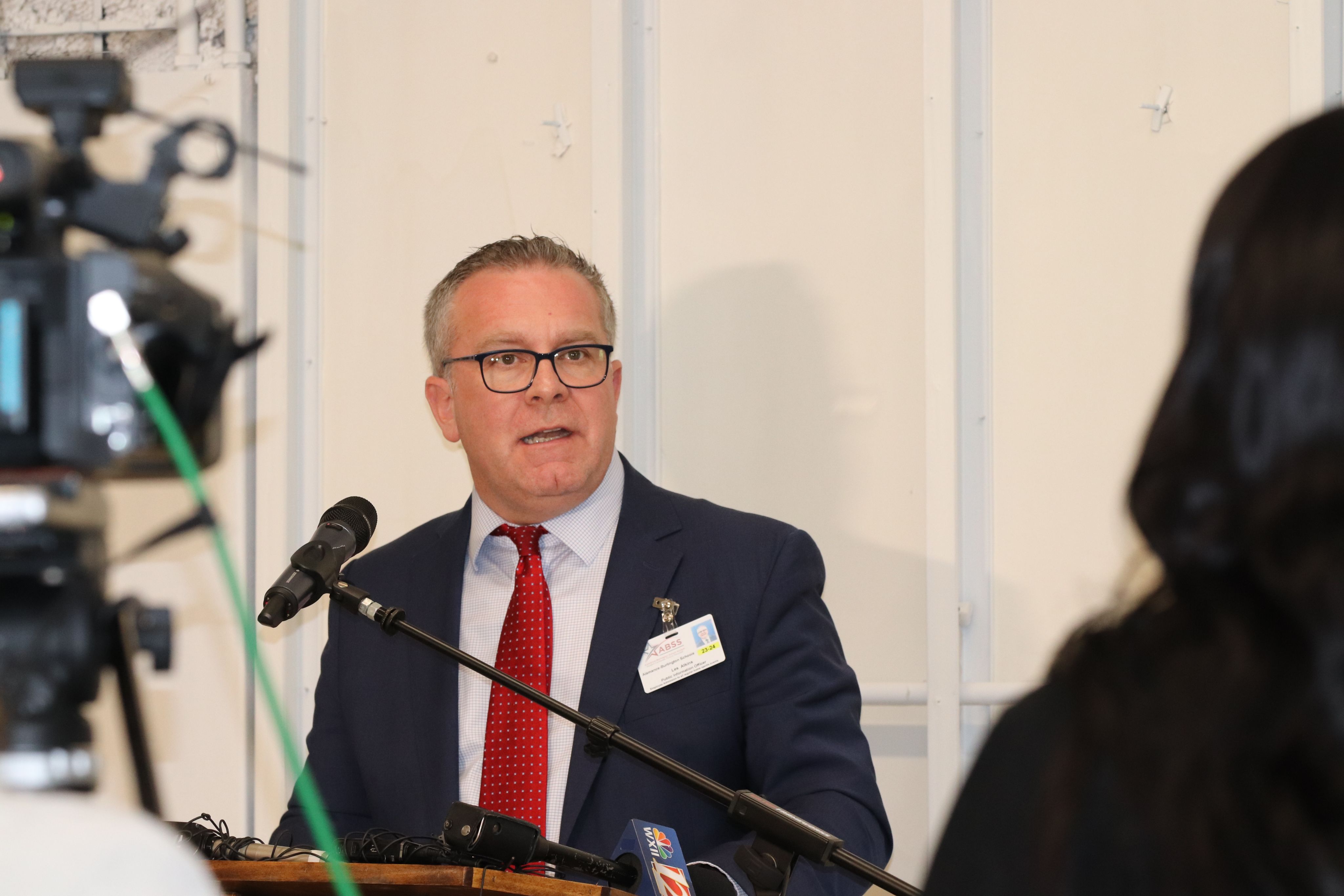
Though Rogers agrees partially that it is the county’s responsibility to take care of the school system, he said he believes the county commissioners should advocate for the district at a higher level.
“Taking that even a step further to possibly request them for a little bit of advocacy to our state level, to be able to make sure that our state is passing along budget that can end up helping us locally too,” Rogers said. “The county commissioners are a part of that funding, but also our state is a big part of that funding too.”
According to Atkins, state funding goes toward teachers, and everything else is handled locally. Atkins said while ABSS cannot request emergency funding from the state, the county commissioners could potentially petition the state for funding if they please.
One of Whittaker’s children, 4-year-old Colton Whittaker, has a growth hormone disorder. When Whittaker heard about the initial mold outbreak, she faced a tough decision.
“The biggest concern for me was if he's in a situation where he's already immunocompromised and his lungs are going to have to work overtime, his pulmonary system is going to have to work overtime just because of the medication that he's on, at what cost do we have to weigh out whether it's comfortable for us to put him in that setting or not?” Whittaker said.
Now that Colton is in school, Whittaker said she worries she won’t be able to protect her son if the mold comes back. Until the school district is able to address the root causes, Whittaker said she believes there needs to be regular testing to make sure the mold is not growing back.
But Atkins said it’s not as simple as it seems.
“That's one of the things that we presented to the county commissioners, because obviously, that would require money, and that's what we need at this point,” Atkins said.
Atkins said in the winter months, the schools are less worried about mold regrowth because there is less humidity. In the spring, however, Atkins said the district will discuss testing again.
While ABSS struggles to scrounge up funding, the district now faces another issue: students and parents have lost trust in the system.
“It was a very rushed process and it’s appeared unsettling,” Whittaker said. “We as parents have lost all faith that anybody is being truthful, and it's just a really uneasy feeling moving forward as, OK, what happens if it comes back? Are they going to tell us?”
The district knows the mold crisis severed trust, and Atkins said during and after the remediation, ABSS has tried to be as open as possible.
“We've really tried to be transparent with our families,” Atkins said. “We communicated every step of the way — like our superintendent says, the good, the bad, the ugly, right? And we wanted to communicate that with our families and to continue to build trust with them because obviously this is a concern that we all have. At the end of the day, we all want the best for our kids.”
But some parents don’t feel that it was enough. ABSS parent Patrick Schwartz said though parents were informed of all the schools that had mold, the big questions parents had were not being answered.
“As you see the list growing of schools with mold, I don't know how you can't start talking about the possibility of a delay and other plans,” Schwartz said.
With the COVID-19 pandemic putting schools in flux for the past couple of years, Rogers said many students have told him they feel their education has been unstable and that the mold crisis has added to that instability.
“It's like everything is a catch up,” Rogers said. “At times they say they can feel overwhelmed, but they don't even know if they have a moment to even feel overwhelmed because they got to get to the next thing.”
The school delay caused similar concerns for Schwartz, who said the mold added to his concerns about declining education scores post-pandemic. The most recent National Assessment of Educational Progress, also known as “The Nation’s Report Card,” in October 2022 found steep declines in math, reading and science proficiency scores across the country compared to pre-pandemic scores from 2019.
“All these kids right now are so much further behind than they should be,” Schwartz said, whose daughter began 6th grade this year. “Especially starting middle school, I didn't want her to fall even further behind.”
Whittaker said she’s concerned her children’s education will remain unstable so long as the conditions for mold growth remain unfixed.
“Without addressing those, this is going to continue to spread, and it’s all going to come back and we’re going to be back here next year,” Whittaker said.
Find your school's air quality reports:
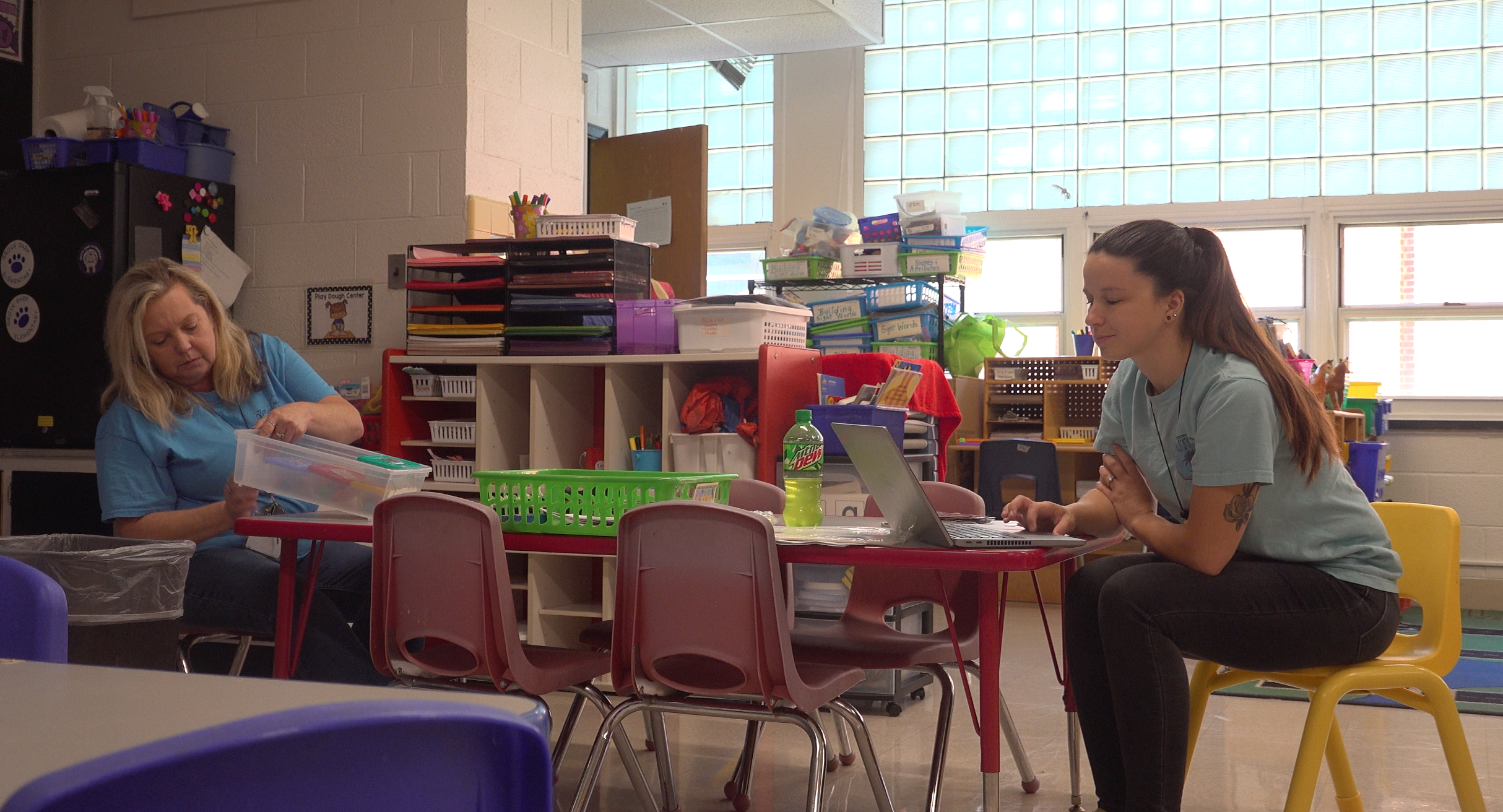
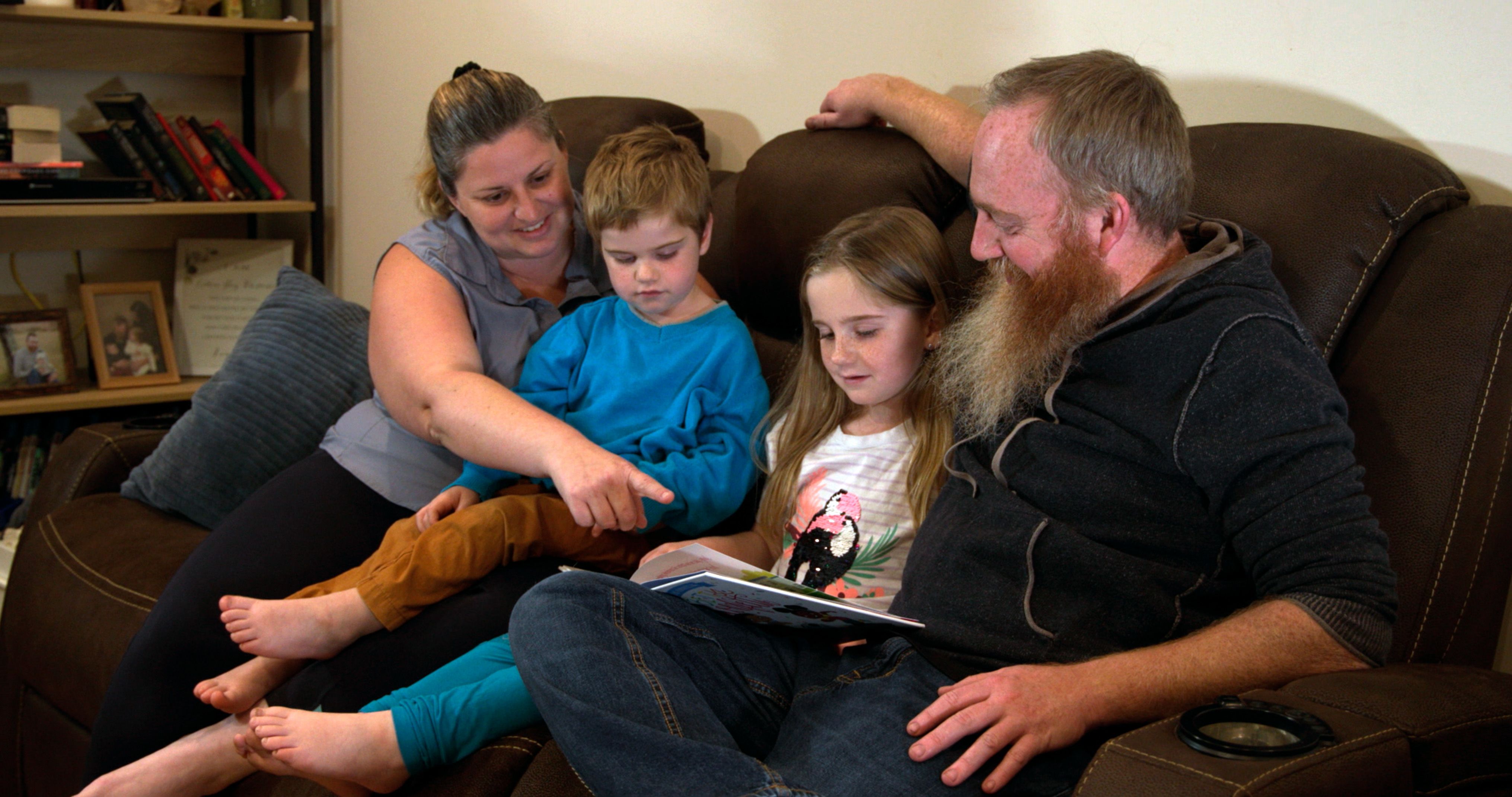

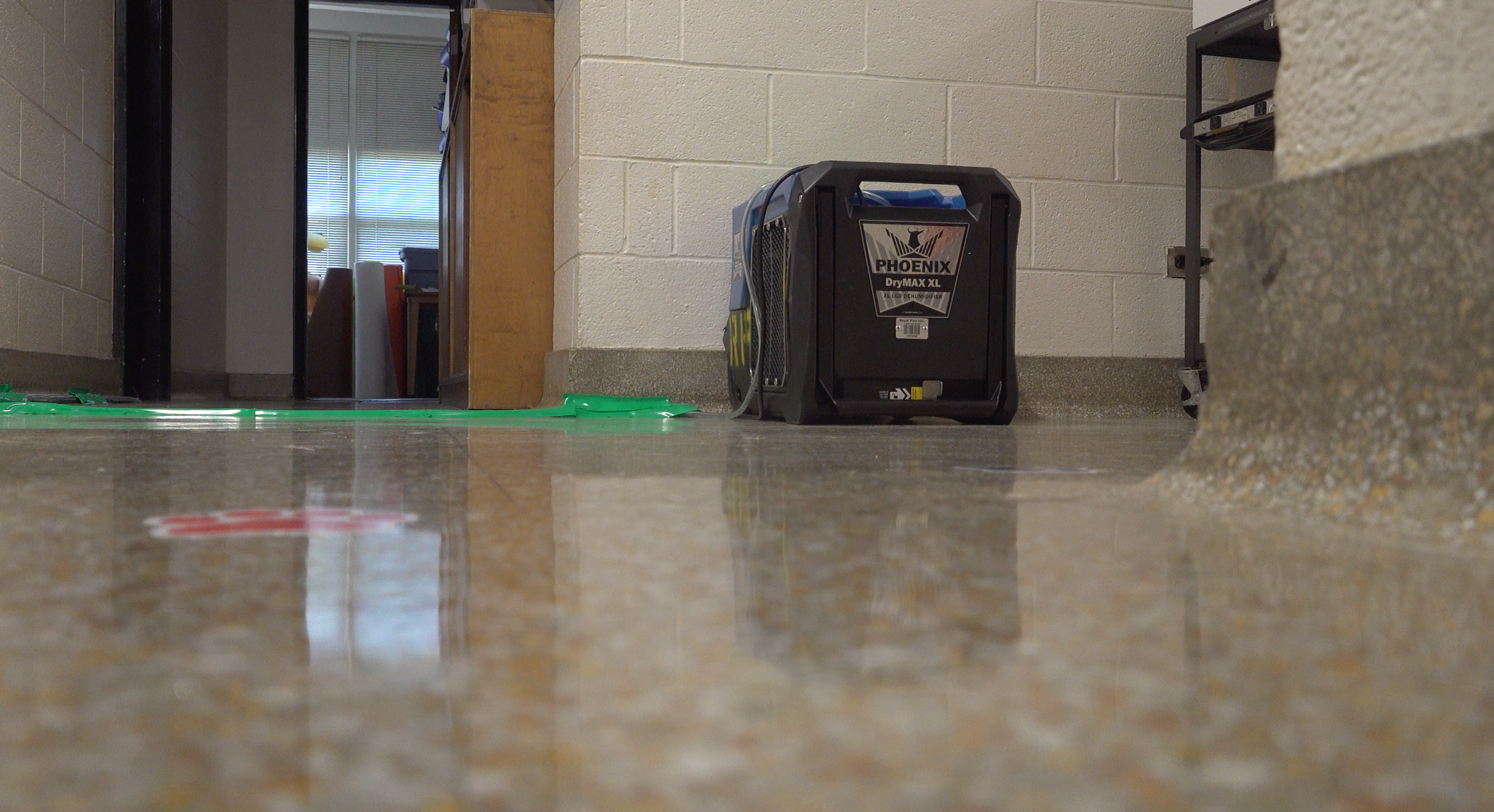

Teachers at Grove Park Elementary get ready for the school year. Photo by Sophie Rosenthal.
Teachers at Grove Park Elementary get ready for the school year. Photo by Sophie Rosenthal.

Brandy Whittaker sits on the couch with her husband William and her children, 4-year-old Colton and 6-year-old Riley, in their home while Riley reads a book out loud. Photo by Sophie Rosenthal.
Brandy Whittaker sits on the couch with her husband William and her children, 4-year-old Colton and 6-year-old Riley, in their home while Riley reads a book out loud. Photo by Sophie Rosenthal.

Brandy Whittaker and her son Colton Whittaker talk about his growth hormone disorder in their home on Nov. 10. Photo by Sophie Rosenthal.
Brandy Whittaker and her son Colton Whittaker talk about his growth hormone disorder in their home on Nov. 10. Photo by Sophie Rosenthal.

A dehumidifier in Grove Park Elementary after the remediation. Photo by Sophie Rosenthal.
A dehumidifier in Grove Park Elementary after the remediation. Photo by Sophie Rosenthal.
